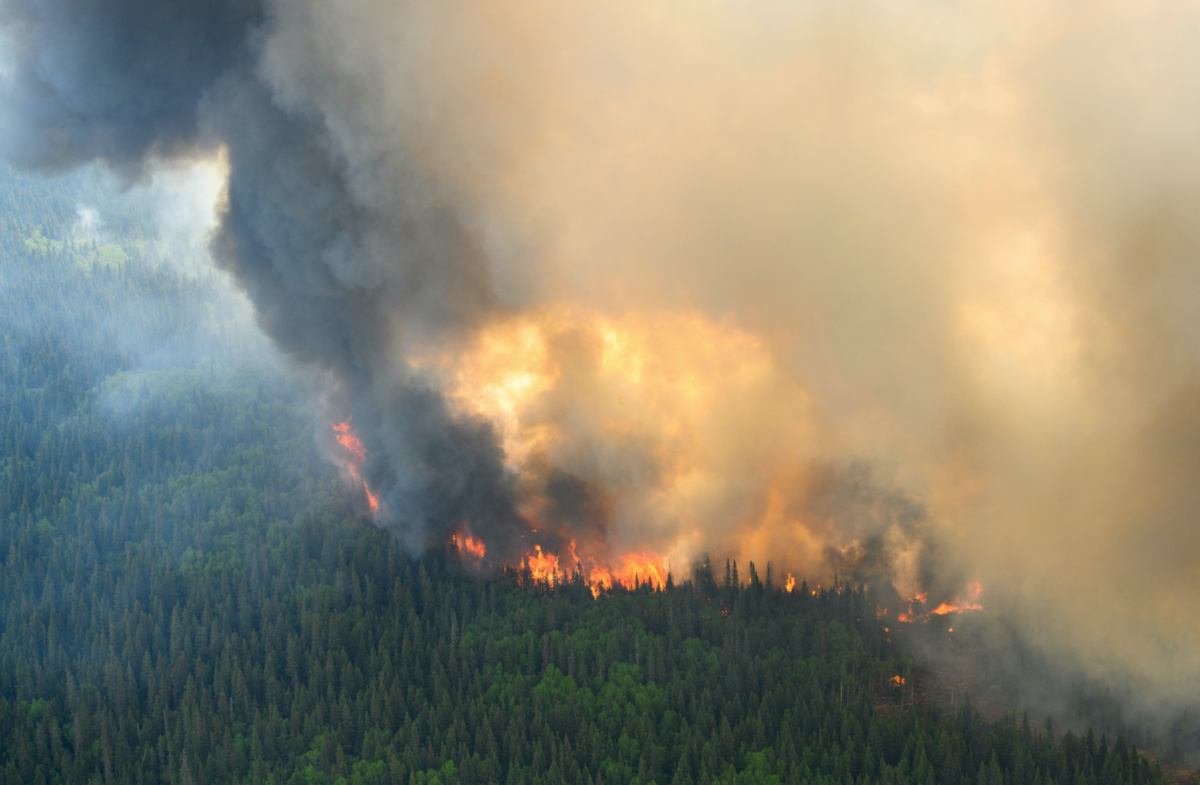British Colombia, Canada
Reuters
Canada is wrestling with its worst-ever start to wildfire season, but recruiting firefighters is becoming increasingly difficult due to tight labor markets and the tough nature of the job, provincial officials say.
Limited resources could threaten Canada’s ability to douse fires, which are expected to get bigger and fiercer in future as a result of fossil fuel-driven climate change, risking more damage to communities and disrupting the country’s oil and gas, mining and lumber industries.

Flames reach upwards along the edge of a wildfire as seen from a Canadian Forces helicopter surveying the area near Mistissini, Quebec, Canada, on 12th June, 2023. PICTURE: Cpl Marc-Andre Leclerc/Canadian Forces/Handout via Reuters/File photo.
A Reuters survey of all 13 provinces and territories showed Canada employs around 5,500 wildland firefighters, not including the remote Yukon territory, which did not respond to requests for information.
That’s roughly 2,500 firefighters short of what is needed, said Mike Flannigan, a professor at Thompson Rivers University in British Columbia and wildfire specialist.
“It’s hard work, it’s hot work, it’s smoky work, and there are real issues with health impacts longer-term,” Flannigan said. “It’s getting harder to recruit and retain people.”
This year Ontario extended its application period, boosted marketing efforts and started covering training costs to secure more recruits. Applications were down in British Columbia and Nova Scotia, and Alberta had to do several rounds of recruitment to fill its ranks, officials said.
Canada’s provinces and territories share crews and equipment as required and call on international partners and the military in times of extreme need. But this year record-breaking blazes flared up simultaneously in the east and west, sparking competition for firefighters and aircraft.
“This was the worst-case scenario that everyone dreads – multiple areas of the country burning at the same time,” said Scott Tingley, forest protection manager for Nova Scotia.
Wildfire crews work 12-14 hour days, up to two weeks at a time, in smoke-filled, high-stress environments, often in remote wilderness areas.
The seasonal work, longer fire seasons and uncompetitive basic pay – ranging from $C30 an hour in British Columbia to $C18 an hour in Manitoba – also deter people.
“We’re in competition with a whole bunch of other labour markets. It’s demanding physical work and it’s mentally taxing,” said Rob Schweitzer, executive director of BC Wildfire Service.
A week of cooler weather and rain eased some fires across Canada but 6.5 million hectares, an area the size of Lithuania, have already burned this year and unusually hot weather is expected to return.
Filling the gaps
This year record fires have resulted in Canada deploying around 550 armed forces personnel and more than 1,700 international firefighters, paid for by the provinces, to beef up its stretched crews. As more wildfires threaten communities, provincial agencies are also increasingly leaning on structural firefighters to help protect homes.
But of the 126,000 structural firefighters in Canada, 90,000 are volunteers, according to the Canadian Association of Fire Chiefs, who are bearing the strain of protecting their own communities while also holding down day jobs.
At the height of the fires in May and June some provinces appealed for extra wildfire recruits. Alberta deployed 157 people who answered a government call-out, Nova Scotia sent out its first 30-person crew of volunteers last week and Quebec trained up an extra 300 volunteers and forestry workers who are not usually part of its wildfire service.
We rely on our readers to fund Sight's work - become a financial supporter today!
For more information, head to our Subscriber's page.
The extra manpower is not cheap. Annual national wildfire protection costs topped C1 billion for six of the last 10 years, according to federal government data and have risen about $C150 million per decade since 1970.
Most experts expect them to keep climbing.
The federal government is spending $C38 million towards hiring, training and retaining firefighters and $C256 million over five years into an equipment fund, and working on a pilot project training structural firefighters. An Emergency Preparedness ministry spokesperson said the government recognises the need for more investment.
“The men and women that fight wildland fires are doing a tremendous job but the fact is there’s not enough of them,” said Ken McMullen, president of the Canadian Association of Fire Chiefs.
– Additional reporting by DAVID LJUNGGREN and ISMAIL SHAKIL in Ottawa






